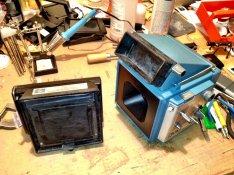aterimagery
Member
Anyone ever worked on a Tektronix oscilloscope camera?

I got this thing off of eBay for $25+shipping, mostly just to get the polaroid back, but it seems like I ought to be able to do something with the actual camera itself. Seems like it's just fixed focus at around the front end of the box, and just uses what's essentially a focusing rail to move the whole camera forward and backward a small distance for focusing. So, limited usefulness unless I manage to modify the optics or something. (I guess I could put some lighting inside it and use it to copy flat images onto instant film for emusion transfers and stuff.)
Anyway, that's not my main problem right now. Right now I just want to power it up and I can't find any information on what the power input should be. It would be easy to hook it up to this power supply I have but I'd rather not just start shooting current into the thing trial-and-error at various voltages until it either works or gets fried.
Here's the control panel on the thing, for what that's worth:

(The aperture/shutter speed controls are mechanically linked and seem like the whole mechanism really needs some oil. But I digress....)
This would appear to be the power connector on the front:

Looks like it just connects to something on the scope when you swing it into position. The black and red wires look pretty obvious but I have no idea what the white-and-black-striped wire would be. Maybe a ground or it could be a sync signal for the "single sweep" exposure mode?
So it will be easy as dirt to connect up some power, if only I could figure out what the input is supposed to be.
I guess I'll keep searching around on boat anchor manual sites, but any pointers or links would be greatly appreciated.

I got this thing off of eBay for $25+shipping, mostly just to get the polaroid back, but it seems like I ought to be able to do something with the actual camera itself. Seems like it's just fixed focus at around the front end of the box, and just uses what's essentially a focusing rail to move the whole camera forward and backward a small distance for focusing. So, limited usefulness unless I manage to modify the optics or something. (I guess I could put some lighting inside it and use it to copy flat images onto instant film for emusion transfers and stuff.)
Anyway, that's not my main problem right now. Right now I just want to power it up and I can't find any information on what the power input should be. It would be easy to hook it up to this power supply I have but I'd rather not just start shooting current into the thing trial-and-error at various voltages until it either works or gets fried.
Here's the control panel on the thing, for what that's worth:

(The aperture/shutter speed controls are mechanically linked and seem like the whole mechanism really needs some oil. But I digress....)
This would appear to be the power connector on the front:

Looks like it just connects to something on the scope when you swing it into position. The black and red wires look pretty obvious but I have no idea what the white-and-black-striped wire would be. Maybe a ground or it could be a sync signal for the "single sweep" exposure mode?
So it will be easy as dirt to connect up some power, if only I could figure out what the input is supposed to be.
I guess I'll keep searching around on boat anchor manual sites, but any pointers or links would be greatly appreciated.










